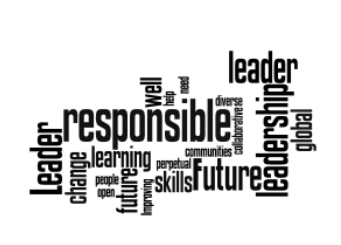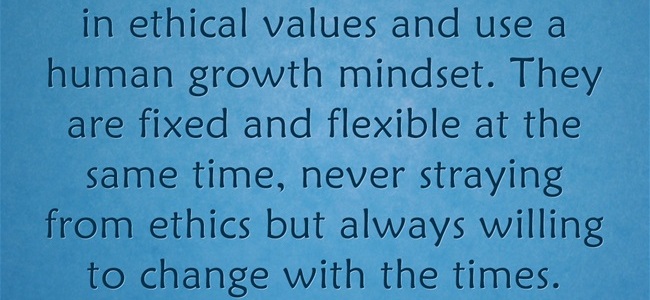By Linda Fisher Thornton Developing competent ethical leaders can be a huge challenge. Why is it so difficult? We live in a globally connected society, and are expected to be globally aware. We are dealing with catastrophic change and uncertainty. We fill many different roles in our organizations, industries and communities. Each role we play and each decision we face has different ethical implications. Ethical competence is definitely not something that “just happens.”
Tag: leading ethically
Ethical Leaders: 10 Behaviors to Avoid
By Linda Fisher Thornton In the lifelong quest to become our best selves, we need to stretch and grow and learn from our mistakes. Being a flexible and willing learner, we will more easily stay competent as the world changes. Here are 10 things to avoid if we are to accomplish the elusive goal of becoming our best selves:
Ethical Leadership Development: Global Awareness
By Linda Fisher Thornton Laws serve as he minimum standards for society, but responsible leadership requires that we go well beyond those minimum standards. This post explores resources that help us understand (1) what it means to be a globally responsible leader and (2) what kinds of learning opportunities help leaders develop a global sense of responsibility.
Ethical Leadership Development: Global Principles
By Linda Fisher Thornton Beyond complying with laws and regulations, what should C-Suite leaders be doing about ethical leadership and responsible business practices? CEOs, CLOs, CHROs and other C-Suite leaders should be working together to ensure that every leader is doing business responsibly and ethically. But what does “doing business responsibly and ethically” look like in today’s global economy? In our interconnected working world, where each economy affects all others around the world, ethical business practices need to be thought about more broadly than ever before.
10 Quotes to Inspire Leaders in 2024 (Part 1)
By Linda Fisher Thornton This series includes 10 quotes (linked to blog posts with leadership guidance) to inspire you and help you improve your leader development as we head into the new year. Part 1 includes the first 5.
Hallmarks of Ethical Leadership (Part 4)
By Linda Fisher Thornton This post is Part 4 in a series. In Part 1, Part 2, and Part 3 I explored 9 different traits that help you recognize ethical leaders. In Part 4 I will address the importance of leading in ways that eliminate fear. One of the hallmarks of ethical leadership is that it is a fear-free zone. Fear is insidious. It changes how we see the world and how we treat others. Here are 5 important reasons why fear has no place in our workplaces, our families or our communities:
Hallmarks of Ethical Leadership (Part 3)
By Linda Fisher Thornton In Hallmarks of Ethical Leadership Part 1and Part 2, I shared 6 special qualities, behaviors and outcomes that define ethical leadership. This week I’ll share three more. These are intentional actions ethical leaders take to stay competent as things change around them.
Responding (Ethically) To An Overwhelmed Employee
By Linda Fisher Thornton "The issue of the overwhelmed employee looms large" according to Josh Bersin, Bersin by Deloitte. (Are You an Overwhelmed Employee? New Research Says Yes, LinkedIn). Employees are having a hard time managing an overload of information and tasks, and the problem is not getting any better.
Building an Ethical Culture (Part 1)
By Linda Fisher Thornton After I published “Prevention or Cure: Your Choice” about reducing ethical risk and creating a positive culture a reader asked for more information about the business case for prevention. Here are some compelling reasons why the prevention approach is a better business decision than waiting for ethical problems and applying a “cure” after the organization is already in trouble.
Top Post Series of 2022: Leading in Context Blog
By Linda Fisher Thornton The Top Post Series for last year on the Leading in Context Blog reflected the urgent need to move ethical thinking and decision making forward in organizations. It featured specific areas of focus and strategies for improving organizational ethics. Use these posts to identify areas you want to improve in 2023.
Will You Give the 12 Gifts of Leadership This Year?
By Linda Fisher Thornton How do we lead when we want to bring out the best in people? These 12 Gifts of Leadership are on the wish lists of employees around the world. They aren't expensive. They don't require dealing with the hustle and bustle of holiday shopping, and one size fits all. Sure, these gifts are harder to give than a fruitcake, but they will be life-changing for those you lead.
Focus on Teaching Students How to Think (Not What To Think)
By Linda Fisher Thornton Have you noticed that the current fray about what to teach about difficult subjects has been focused on teaching "one way or the other?" "Are you for it or against it? and "Which side are you on?" This approach completely misses the point that the purpose of education is not to teach students what to think. It's to teach students how to think, and how to navigate differences respectfully.
Leading the Return to In-Person Work: 5 Perspectives
By Linda Fisher Thornton This week I am sharing 5 interesting articles that tackle the challenge of leading the process of returning to in-person work. They each share a slightly different perspective. As a reminder, there are many human issues to consider beyond just keeping people well as we learn to live with COVID-19, and I discussed some of them in a previous post. Below are 5 additional resources, each highlighting issues to consider as you lead the return to the office this fall.
Recognizing Ethical Issues (Part 6)
By Linda Fisher Thornton In Part 1 of this series on Recognizing Ethical Issues, I addressed the gaps in our thinking that require us to develop an ethical alert system. in Part 2, I explored why some leaders who want to do the right thing still don't "do the work" to learn how to do it. In Part 3, I dug into the importance of ethical awareness as the basis for ethical decision making. In Part 4 I described ways to develop ethical thinking. In Part 5, I shared some recent blog posts about how to recognize ethical issues in current events and make good decisions about them. In Part 6, I provide an overview of each post in the series and an opportunity for you to practice recognizing ethical issues with your teams.
Recognizing Ethical Issues (Part 5)
By Linda Fisher Thornton In Part 1 of this series on Recognizing Ethical Issues, I addressed the gaps in our thinking that require us to develop an ethical alert system. in Part 2, I explored why some leaders who want to do the right thing still don't "do the work" to learn how to do it. In Part 3, I dug into the importance of ethical awareness as the basis for ethical decision making. Part 4 described ways to start developing ethical thinking. In Part 5, I share some recent posts that address current societal issues. Read the ones below that strike you as the most relevant, to learn about how to recognize the nuances of ethical issues in current events and make good decisions about them.














